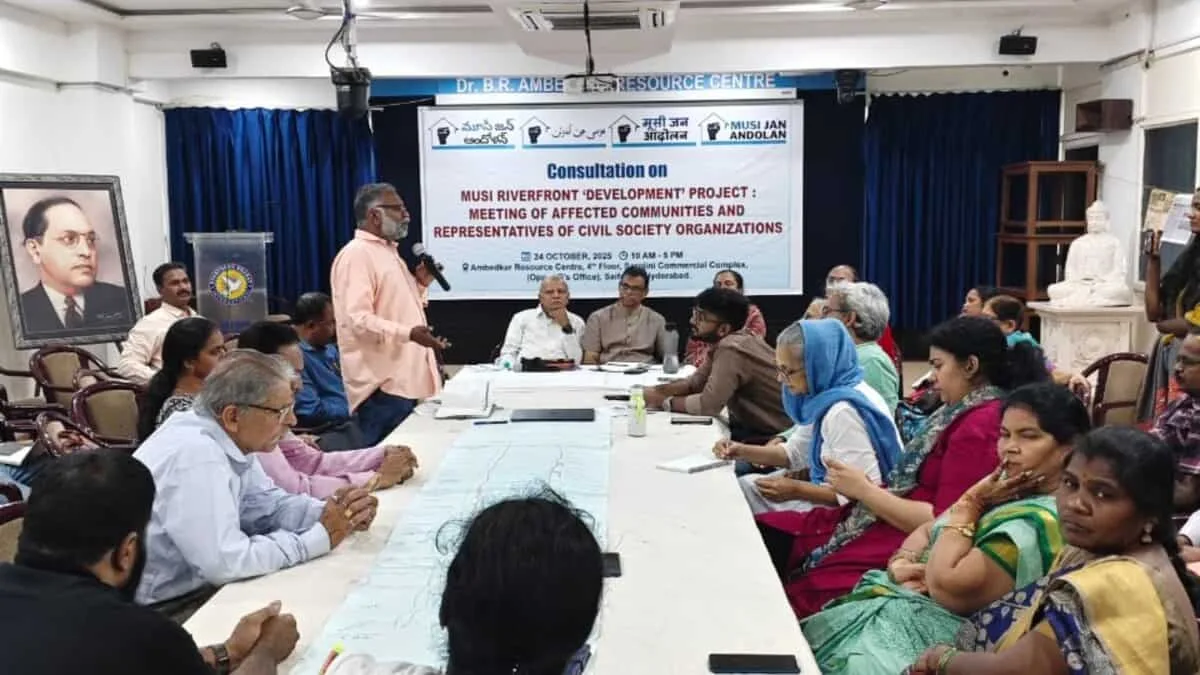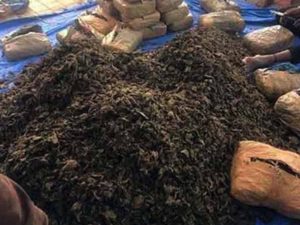Hyderabad: Has the Asian Development Bank (ADB) sanctioned Rs 4,100 crore for the Musi Riverfront Development Project? What does the pre-feasibility report of the project talk about? Is the detailed project report (DPR) for the project ready? How will the state government deal with relocation and rehabilitation of the people living on the banks of the Musi River? How is the government going to address the core issue of pollution affecting the river? What is the success rate of river rejuvenation projects in the country?
These were the questions deliberated upon by the potential land oustees of the project, as well as the activists who have seen the same project changing names for the past few decades, in the name of nandanavanam, beautification, and presently riverfront development and rejuvenation.
Activists and subject matter experts congregated under the banner ‘Musi Jan Andolan‘ at Ambedkar Resource Centre in Hyderabad on Friday, October 24, to discuss the way forward.
The discussions began with people from the banks of the Musi and its nalas from several areas including Langar House, Bandlaguda Jagir, Kachiguda, Moosa Nagar, Kamala Nagar, Shankar Nagar and Nagole in Hyderabad, and all the way up to Edulabad in Yadadri Bhuvanagiri district voiced their concerns for and against the rejuvenation project.
Residents of several areas expressed apprehensions about their houses located in the buffer-zone that were demarcated in October 2024, and wondered what would happen to their houses built with their hard earned money.
Though all these areas were not similar, as some were gram panchayat layouts while others were slums, one similarity between them is that most of these houses either had registered pattas, or had notarised documents, and people have been living here for decades.
While some reported no flood water entering their houses this year, there were also those whose houses got submerged for the first time. Slum dwellers also alleged that this was the first time that the officials didn’t give them prior warning before releasing water from the Osmansagar and Himayatsagar reservoirs, which caused flooding.
Displacement again and again
Brother Varghese of Montfort Social Institute gave instances of how the residents of Kamal Nagar became the victims of displacement multiple times, and also gave examples of good rehabilitation in the 1960s, 1970s and also in the recent times, whenever the officials concerned were compassionate and took constructive decisions for the welfare of the basti people.
“It is not about the river versus people, but the river and the people. Integrate the people into the project, protect the households and their livelihoods. Recognise the people’s ownership of their houses and provide them alternative housing and facilities within 2-3 km from their alienated land,” he suggested the government.
Disputed data
Varghese claimed that as against 1,400 structures located in the river bed and 8,000 structures in the buffer-zone as being proposed by the state government for relocation, there were actually around 20,000 households with 1,30,000 people who will be affected due to displacement for the Musi project.
He also alleged that the buffer-zone was constantly being expanded from 9 metre to 30 metre, then 50 metre, and 100 metre, to cater to the needs of the real estate firms and the potential contractors of the Musi project.
He said that there were 8 acres of land in Uppal where some of the households could be relocated.
Officials biased in favour of big realtors
Environmental activist Dr Lubna Sarwath explained how the officials were looking the other way when it came to taking action against the big realtors encroaching the Musi river bed, going to the entent of building a retaining wall inside the river, and the ruling establishment constructing service roads right inside the river bed, to serve the interests of these very realtors.
Modi government helped Congress in Telangana
Talking about the pre-feasibility report of the Musi project, POW Sandhya observed a conspiracy behind the Modi government at the Centre involving the Congress government in Telangana to get Rs 4,100 crore sanctioned by ADB.
“They are going to demolish all the houses at Bapu Ghat to build the tallest statue of Mahatma Gandhi. They are talking about walking-tracks and high-rises, renovating temples, mosques and churches in the name of beautification. They are also planning to setup special economic zones at Chandanavelli and Sitarampur under the project. All these heavy constructions only act as an obstruction to the flow of the Musi river. This is not people-centric development,” she stated.
Who is the real beneficiary?
Kamal, an activist representing the potential land oustees of HydershaKote in Bandlaguda revealed that the survey conducted by them found 1,200 structures being affected by the project between the Narsinghi and Attapur stretch.
“Who should be the beneficiary of this project? Is it those who are losing their houses and livelihoods, or those who are going to setup their businesses after displacing the people in these areas? Don’t replace them, uplift them,” he demanded.
Disengagement with people and democracy
K Babu Rao, retired scientist at Indian Institute of Chemical Technology (IICT) accused the state government of taking up the Musi project as a construction project without either consulting, or engaging the affected people in the process.
On the state government emulating the South Korean government’s Cheonggyecheon stream redevelopment and Han riverfront beautification projects, he reminded that the Mayor of Seoul had made changes to that project after consulting the people 4,000 times in the process.
On chief minister A Revanth Reddy branding those opposing the Musi project as anti-Telangana and anti-nationals, Babu Rao, a human rights activist questioned why the people needed to bear the burden of Rs 1.5 lakh crore being estimated to be spent on the project, when they have already been branded so.
Wrong guys wrote Musi pre-feasibility report
He also stated that the pre-feasibility report of the Musi Riverfront Development Project was prepared by certain officials in L&T Infrastructure, who prepared a faulty Environmental Impact Assessment (EIA) report for the National Investment and Manufacturing Zone (NIMZ) in Zaheerabad, and were removed from their services after they were exposed by the Human Rights Forum (HRF).
“The same people established a new company and are now being given projects by Andhra Pradesh and Telangana governments,” he alleged, also noting that there was not even a single point in the pre-feasibility report on rejuvenating the Musi river.
What Mahatma Gandhi said
“Mahatma Gandhi said that every work done by the government, should see happiness in the eyes of the people. Whether it is the proposed Future City, or the Musi Rejuvenation, or anything else, nothing will happen unless the democracy is restored in Telangana,” he underlined.
How pollution has affected Musi downstream areas in Nalgonda
Batta Shankar and Pittala Srisailam, who have been waging movements for the rejuvenation of the Musi river for the past three decades, explained how the erstwhile Nalgonda district located downstream of the Musi river, has been bearing the brunt of pollution of the Musi river upstream.
Shankar explained that there were 98 villages falling under the Nagole-Suryapet belt along the flow of the Muri river, and that the Edulabad Cheruvu in Edulabad village in the present Yadadri Bhuvanagiri district, which was the principal source of drinking water for his villagers and thousands of cattle in 1992; had become totally contaminated by 1998-99.
The source of the pollution, he said, was the 18 km pipeline that was laid from Kukatpally Y Junction to Golnaka in that period, which carried the industrial effluents from the bulk drug companies in Patancheru industrial area, and delivered it to Golnaka, where it merged with the Musi river.
Though it was originally intended to be a zero-discharge mechanism to address pollution, he said the cost of delivering the industrial effluents by the companies through tankers as directed by the court, was not financially feasible for the bulk drug companies, which continued to dump their effluents which ended up flowing into the Musi river.
As a result, he said that the downstream villages in the erstwhile Nalgonda districts had to bear the brunt of polluted water.
“There used to be a miscarriage in one out of three households in our village. In 1996, 97 and 98, all fishes in Edulabad Cheruvu died, causing a loss of Rs 1 lakh to the fishermen community at the time. The lab tests revealed even more dangerous contamination. Groundwater in 2 km distance from our village was totally contaminated. There was 40 percent reduction in paddy yield, which was also polluted. Not only humans, but also the bovine animals suffered miscarriage. There needs no mention about the prevalence of cancer, high blood pressure and diabetes in the villages,” he recounted.
“We don’t drink milk produced in our villages. We don’t consume rice produced there. All that contaminated food and milk comes to Hyderabad. You have to remember that we are all in this together,” he cautioned the residents of Hyderabad, also warning of the superbug recently found by the scientists in the irrigation tanks and the Musi river by scientists, as a result of mutation due to contamination of the water bodies, which is immune to medicines.
“There is a major catastrophe going to happen in Hyderabad just like the Bhopal gas tragedy,” he warned.
STPs or ETPs?
He opined that setting up the tried and tested Sewage Treatment Plants (STP) has failed in the past, and will continue to fail with regard to the rejuvenation of the Musi river, and that one solution could be to setup Effluent Treatment Plants (ETP) along the Musi river and the water bodies which form a chain-link accessing water from the river.
He also suggested de-silting of the irrigation tanks in the region, so that the accumulated chemical effluents could be removed.
“The pollution control board people are only worried about their families and not about anything else. There was a time when 10,000 people assembled at their office and questioned them. Today that spirit is missing,” he added.
Ramky and Jawaharnagar dump yard
The speakers also raised alleged that the Ramky Group has been dumping the leachate after processing the waste-to-energy at the Jawaharnagar dumping yard, inside the water bodies. They pointed out the Central Pollution Control Board’s (CPCB) report on the dangerous chemical and metal residues found in the leachate.
No success stories in India
Activist Ruchith said that not a single river rejuvenation project in India has been successful till now, including the Sabarmati Riverfront Development Project, where Narmada river water was being diverted to Sabarmati River, for a project which cost Rs 1,400 crore, or even more in Gujarat- which Telangana government wants to emulate.
“As per the CPCB’s report of 2022, Sabarmati river still stands as the second-most polluted river in the country,” he pointed out.
He also said that a similar rejuvenation project undertaken in Jammu resulted in the washing away of the developed riverfront there, along with the STPs installed there due to floods.
He mentioned that severe opposition has been coming from the people in Pune against similar riverfront development projects there in the recent times.
“Why are they constructing roads, lanes and other infrastructure along the banks of the rivers, when the right thing to do is to leave the river to flow naturally,” he wondered.







